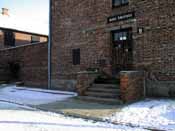After the war, some of those responsible for crimes committed during the Holocaust were brought to trial. Nuremberg, Germany, was chosen as a site for trials that took place in 1945 and 1946. Judges from the Allied powers -- Great Britain, France, the Soviet Union, and the United States -- presided over the hearings of twenty-two major Nazi criminals.
Twelve prominent Nazis were sentenced to death. Most of the defendants admitted to the crimes of which they were accused, although most claimed that they were simply following the orders of a higher authority. Those individuals directly involved in the killing received the most severe sentences. Other people who played key roles in the Holocaust, including high-level government officials, and business executives who used concentration camp inmates as forced laborers, received short prison sentences or no penalty at all.
The Nazis' highest authority, the person most to blame for the Holocaust, was missing at the trials. Adolf Hitler had committed suicide in the final days of the war, as had several of his closest aides. Many more criminals were never tried. Some fled Germany to live abroad, including hundreds who came to the United States.
Trials of Nazis continued to take place both in Germany and many other countries. Simon Wiesenthal, a Nazi-hunter, located Adolf Eichmann in Argentina. Eichmann, who had helped plan and carry out the deportations of millions of Jews, was brought to trial in Israel. The testimony of hundreds of witnesses, many of them survivors, was followed all over the world. Eichmann was found guilty and executed in 1962
KEY DATES
AUGUST 8, 1945
CHARTER OF THE INTERNATIONAL MILITARY TRIBUNAL (IMT) ANNOUNCED AT LONDON CONFERENCE
The International Military Tribunal (IMT) is composed of judges from the United States, Great Britain, France and the Soviet Union. Leading Nazi officials will be indicted and placed on trial in Nuremberg, Germany, under Article 6 of the IMT's Charter for the following crimes: (1) Conspiracy to commit charges 2, 3, and 4, which are listed here; (2) crimes against peace--defined as participation in the planning and waging of a war of aggression in violation of numerous international treaties; (3) war crimes--defined as violations of the internationally agreed upon rules for waging war; and (4) crimes against humanity--"namely, murder, extermination, enslavement, deportation, and other inhumane acts committed against any civilian population, before or during the war; or persecution on political, racial, or religious grounds in execution of or in connection with any crime within the jurisdiction of the Tribunal, whether or not in violation of domestic law of the country where perpetrated."
OCTOBER 6, 1945
LEADING NAZI OFFICIALS INDICTED FOR WAR CRIMES
The four chief prosecutors of the International Military Tribunal (IMT)--Robert H. Jackson (United States), Francois de Menthon (France), Roman A. Rudenko (Soviet Union), and Sir Hartley Shawcross (Great Britain)--hand down indictments against 24 leading Nazi officials. The indicted include Hermann Goering (Hitler's heir designate), Rudolf Hess (deputy leader of the Nazi party), Joachim von Ribbentrop (foreign minister), Wilhelm Keitel (head of the armed forces), Wilhelm Frick (minister of the interior), Ernst Kaltenbrunner (head of security forces), Hans Frank (governor-general of occupied Poland), Konstantin von Neurath (governor of Bohemia and Moravia), Erich Raeder (head of the navy), Karl Doenitz (Raeder's successor), Alfred Jodl (armed forces command), Alfred Rosenberg (minister for occupied eastern territories), Baldur von Schirach (head of the Hitler Youth), Julius Streicher (radical Nazi antisemitic publisher), Fritz Sauckel (head of forced-labor allocation), Albert Speer (armaments minister), and Arthur Seyss-Inquart (commissioner for the occupied Netherlands). Martin Bormann (Hitler's adjutant) is to be tried in absentia.
OCTOBER 1, 1946
VERDICT AT NUREMBERG
The International Military Tribunal (IMT) announces its verdicts. It imposes the death sentence on 12 defendants (Goering, Ribbentrop, Keitel, Kaltenbrunner, Rosenberg, Frank, Frick, Streicher, Sauckel, Jodl, SeyssInquart, and Bormann). Three are sentenced to life imprisonment (Hess, economics minister Walther Funk, and Raeder). Four receive prison terms ranging from 10 to 20 years (Doenitz, Schirach, Speer, and Neurath). The court acquits three defendants: Hjalmar Schacht (economics minister), Franz von Papen (German politician who played an important role in Hitler's appointment as chancellor), and Hans Fritzsche (head of press and radio). The death sentences are carried out on October 16, 1946, with two exceptions: Goering committed suicide shortly before his scheduled execution, and Bormann remained missing. The other 10 defendants are hanged, their bodies cremated, and the ashes deposited in the Iser River. The seven major war criminals sentenced to prison terms are remanded to the Spandau Prison in Berlin.







